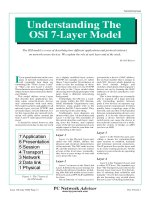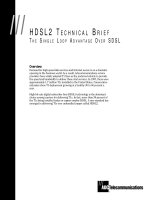Tài liệu Beginning HTML & CSS doc
Bạn đang xem bản rút gọn của tài liệu. Xem và tải ngay bản đầy đủ của tài liệu tại đây (15.4 MB, 674 trang )
www.it-ebooks.info
www.it-ebooks.info
BEGINNING HTML & CSS
INTRODUCTION xxxiii
CHAPTER 1
Structuring Documents fortheWeb 1
CHAPTER 2 Fine-tuning Your Text 39
CHAPTER 3 Links and Navigation 55
CHAPTER 4 Images, Audio, and Video 79
CHAPTER 5 Tables 111
CHAPTER 6 Forms 139
CHAPTER 7 Cascading Style Sheets 191
CHAPTER 8 More Cascading Style Sheets 257
CHAPTER 9 Rounded Corners, Animations, Custom Fonts, and More
with CSS3 311
CHAPTER 10 Learning JavaScript 339
CHAPTER 11 Working with jQuery 383
CHAPTER 12 jQuery: Beyond the Basics 407
CHAPTER 13 Checklists 437
APPENDIX A Answers to Exercises 447
APPENDIX B HTML Element Reference 475
APPENDIX C CSS Properties 515
APPENDIX D Color Names and Values 551
APPENDIX E Character Encodings 561
APPENDIX F Special Characters 565
APPENDIX G Language Codes 577
APPENDIX H MIME Media Types 583
APPENDIX I Changes between HTML4 and HTML5 595
INDEX 603
www.it-ebooks.info
www.it-ebooks.info
BEGINNING
HTML & CSS
www.it-ebooks.info
www.it-ebooks.info
BEGINNING
HTML & CSS
Rob Larsen
www.it-ebooks.info
Beginning HTML & CSS
Published by
John Wiley & Sons, Inc.
10475 Crosspoint Boulevard
Indianapolis, IN 46256
www.wiley.com
Copyright © 2013 by John Wiley & Sons, Inc., Indianapolis, Indiana
Published simultaneously in Canada
ISBN: 978-1-118-34018-9
ISBN: 978-1-118-34028-8 (ebk)
ISBN: 978-1-118-41651-8 (ebk)
ISBN: 978-1-118-65351-7 (ebk)
Manufactured in the United States of America
10 9 8 7 6 5 4 3 2 1
No part of this publication may be reproduced, stored in a retrieval system or transmitted in any form or by any means,
electronic, mechanical, photocopying, recording, scanning or otherwise, except as permitted under Sections 107 or 108 of
the 1976 United States Copyright Act, without either the prior written permission of the Publisher, or authorization through
payment of the appropriate per-copy fee to the Copyright Clearance Center, 222 Rosewood Drive, Danvers, MA 01923,
(978) 750-8400, fax (978) 646-8600. Requests to the Publisher for permission should be addressed to the Permissions
Department, John Wiley & Sons, Inc., 111 River Street, Hoboken, NJ 07030, (201) 748-6011, fax (201) 748-6008, or
online at />Limit of Liability/Disclaimer of Warranty: The publisher and the author make no representations or warranties with respect
to the accuracy or completeness of the contents of this work and specifically disclaim all warranties, including without
limitation warranties of fitness for a particular purpose. No warranty may be created or extended by sales or promotional
materials. The advice and strategies contained herein may not be suitable for every situation. This work is sold with the
understanding that the publisher is not engaged in rendering legal, accounting, or other professional services. If professional
assistance is required, the services of a competent professional person should be sought. Neither the publisher nor the author
shall be liable for damages arising herefrom. The fact that an organization or Web site is referred to in this work as a citation
and/or a potential source of further information does not mean that the author or the publisher endorses the information the
organization or Web site may provide or recommendations it may make. Further, readers should be aware that Internet Web
sites listed in this work may have changed or disappeared between when this work was written and when it is read.
For general information on our other products and services please contact our Customer Care Department within the
United States at (877) 762-2974, outside the United States at (317) 572-3993 or fax (317) 572-4002.
Wiley publishes in a variety of print and electronic formats and by print-on-demand. Some material included with standard
print versions of this book may not be included in e-books or in print-on-demand. If this book refers to media such as a CD
or DVD that is not included in the version you purchased, you may download this material at http://booksupport
.wiley.com
. For more information about Wiley products, visit www.wiley.com.
Library of Congress Control Number: 2012954405
Trademarks: Wiley, the Wiley logo, Wrox, the Wrox logo, Programmer to Programmer, and related trade dress are
trademarks or registered trademarks of John Wiley & Sons, Inc. and/or its affiliates, in the United States and other
countries, and may not be used without written permission. All other trademarks are the property of their respective
owners. John Wiley & Sons, Inc., is not associated with any product or vendor mentioned in this book.
www.it-ebooks.info
For Jo & Ingmar. I’ll take good care of Jude.
www.it-ebooks.info
www.it-ebooks.info
ABOUT THE AUTHOR
ROB LARSEN has more than 13 years of experience as a front-end engineer
and team lead, building websites and applications for some of the world’s
biggest brands.
He is an active writer and speaker on web technology with a special focus
on emerging standards like HTML5, CSS3, and the ongoing evolution of the
JavaScript programming language. He is co-author of Professional jQuery
(Wrox). He’s also active in the open source community, helping to bridge
the gap between the front lines of web development and the people actively
working on the tools that drive the web.
In his career Rob has spent time at Sapient Global Markets, Isobar, The Brand Experience, and
Cramer and as an independent consultant. Over the years, he has solved unique problems for clients
such as Samsung, Adidas, Motorola, Philips, Reebok, Gillette, Boston’s Museum of Science, and
Harvard Kennedy School.
(Photo by RicaRdo Salema:
www.ricardosalema.com)
www.it-ebooks.info
www.it-ebooks.info
Executive Editor
Carol Long
Project Editor
Katherine Burt
Technical Editor
Dan Maharry
Production Editor
Daniel Scribner
Copy Editor
San Dee Phillips
Editorial Manager
Mary Beth Wakefield
Freelancer Editorial Manager
Rosemarie Graham
Associate Director of Marketing
David Mayhew
Marketing Manager
Ashley Zurcher
Business Manager
Amy Knies
Production Manager
Tim Tate
Vice President and Executive
Group Publisher
Richard Swadley
Vice President and Executive Publisher
Neil Edde
Associate Publisher
Jim Minatel
Project Coordinator, Cover
Katie Crocker
Compositor
Craig Woods, Happenstance Type-O-Rama
Proofreader
Nicole Hirschman
Indexer
Robert Swanson
Cover Designer
Elizabeth Brooks
Cover Image
©Aliaksandr Zabudzko/iStockphoto
CREDITS
www.it-ebooks.info
www.it-ebooks.info
ACKNOWLEDGMENTS
I’D LIKE TO THANK CAROL LONG and the rest of the folks at Wiley for giving me this opportunity.
Without it, I probably would have spent half the summer playing video games.
I have to thank Katherine Burt a million times over for her patience and assistance in getting this
slow-to-start monster up to speed.
Dan Maharry’s technical insight has been invaluable—teaching me a thing or two every chapter and
asking the right questions throughout the process. It’s a much better book for his involvement.
At the pace I wrote some of this I’d be nuts not to thank our copy editor, San Dee Phillips. I should
have apologized in advance.
I’d also like to thank Lynn Haller from Studio B for her ongoing help in navigating the business side
of book writing.
I’ve got to give a big shout-out to John Duckett—standing on the shoulders of giants and all that.
As always, I want to thank all the great front-end engineers I’ve worked with at Cramer, Isobar, and
Sapient for pushing me to be a better programmer, manager, and colleague.
Finally, I’d like to thank my wife for her support and understanding throughout this process. I couldn’t
have done it without her.
www.it-ebooks.info
www.it-ebooks.info
CONTENTS
INTRODUCTION xxxiii
CHAPTER 1: STRUCTURING DOCUMENTS FORTHEWEB 1
A Web of Structured Documents 1
Introducing HTML5 2
Tags and Elements 4
Separating Heads from Bodies 5
Attributes Tell You about Elements 6
Learning from Others by Viewing Their Source Code 8
Elements for Marking Up Text 8
Attribute Groups 9
Core Attributes 9
The id Attribute 10
The class Attribute 10
The title Attribute 10
The style Attribute 11
Internationalization 11
The dir Attribute 11
The lang Attribute 12
Core Elements 13
About DOCTYPEs 13
The <html> Element 13
The <head> Element 13
The <title> Element 14
Links and Style Sheets 15
Ensuring Backward Compatibility for HTML5 Tags 15
The <body> Element 16
Common Content Elements 16
Basic Text Formatting 17
White Space and Flow 17
Creating Headings Using <hn> Elements 18
Creating Paragraphs Using the <p> Element 20
Creating Line Breaks Using the <br> Element 20
Creating Preformatted Text Using the <pre> Element 21
Understanding Block and Inline Elements 24
CONTENTS
CHAPTER 1: ABOUT THE AUTHOR
HAPTER 2: CREDITS
HAPTER 3: ACKNOWLEDGMENTS
ION
Is For
Need to Use This Book
Is Organized
Errata
HAPTER 4: STRUCTURING DOCUMENTS FORTHEWEB
Introducing HTML5
Groups
Elements
Inline Elements
Grouping Content
HAPTER 5: FINETUNING YOUR TEXT
Elements That Describe Text-Level Semantics
Editing Text
Entities for Special Characters
www.it-ebooks.info
xvi
CONTE NTS
Grouping Content 25
The New Outline Algorithm in HTML5 25
The <div> Element 26
The <header> Element 26
The <hgroup> Element 27
The <nav> Element 27
The <section> Element 27
The <article> Element 28
The <hr> Element 28
The <blockquote> Element 28
Using the cite Attribute with the <blockquote> Element 29
The <aside> Element 29
The <footer> Element 29
The <address> Element 30
Working with Lists 30
Using the <ul> Element to Create Unordered Lists 30
Ordered Lists 31
Using the start Attribute to Change the Starting Number in
Ordered Lists 32
Count Down in Your Ordered Lists with the reversed Attribute 32
Specify a Marker with the type Attribute 33
Definition Lists 33
Nesting Lists 34
Summary 35
CHAPTER 2: FINETUNING YOUR TEXT 39
Elements That Describe Text-Level Semantics 39
The <span> Element 39
The <em> Element 40
The <strong> Element 40
The <b> Element 41
The <i> Element 41
<strong> versus <b> and <em> versus <i> 41
The <small> Element 41
The <cite> Element 41
The <q> Element 42
The <dfn> Element 42
The <abbr> Element 42
The <time> Element 43
The <code> Element 44
<figure> and <figcaption> Elements 44
The <var> Element 45
www.it-ebooks.info
xvii
CONTE NTS
The <samp> Element 45
The <kbd> Element 45
The <sup> Element 46
The <sub> Element 46
The <mark> Element 46
Editing Text 49
Using Character Entities for Special Characters 51
Comments 51
Summary 52
CHAPTER 3: LINKS AND NAVIGATION 55
Basic Links 56
Linking to Other Web Pages 56
Linking to E-mail Addresses 57
Understanding Directories and Directory Structures 60
Understanding URLs 61
Absolute and Relative URLs 63
Same Directory 64
Subdirectory 64
Parent Directory 64
From the Root 65
The <base> Element 65
Creating In-Page Links with the <a> Element 65
Creating a Source Anchor with the href Attribute 65
Creating a Destination Anchor Using the name and id Attributes
(Linking to a Specific Part of a Page) 66
The <a> Element’s Other Attributes 68
The accesskey Attribute 69
The hreflang Attribute 69
The rel Attribute 69
The tabindex Attribute 70
The target Attribute 71
The title Attribute 71
The type Attribute 71
Advanced E-mail Links 74
Summary 75
CHAPTER 4: IMAGES, AUDIO, AND VIDEO 79
Adding Images Using the <img> Element 80
The src Attribute 80
The alt Attribute 81
www.it-ebooks.info
xviii
CONTE NTS
The height and width Attributes 81
Adding Images to a Web Page 82
Using Images as Links 84
Choosing the Right Image Format 85
GIF Images 87
Animated GIFs 90
JPEG Images 91
PNG Images 92
Keeping File Sizes Small 92
Adding Flash, Video, and Audio to Your Web Pages 95
Adding YouTube Movies to Your Web Pages 95
Adding Rich Media with the <audio> and <video> Elements 97
Controlling Playback with the preload, autoplay, loop, and
muted Attributes 97
Using the poster Attribute to Customize the Initial Frame 98
Adding Video Playback Controls with the controls Attribute 98
Adding Audio to Your Web Pages Using the <audio> Element 99
On Containers and Codecs 99
Adding Flash Movies to Your Web Pages 100
Cross-Browser Video—Using Video for Everybody 103
Video Size 104
A Closer Look at the <object> and <param> Elements 104
The data Attribute 105
The height and width Attributes 105
The tabindex Attribute 105
The usemap Attribute 105
The <param> Element 105
Summary 106
CHAPTER 5: TABLES 111
Introducing Tables 111
Basic Table Elements and Attributes 118
The <table> Element Creates a Table 119
The dir Attribute 119
The <tr> Element Contains Table Rows 119
The <td> and <th> Elements Represent Table Cells 119
The colspan Attribute 119
The headers Attribute 120
The rowspan Attribute 120
The scope Attribute 120
Creating a Basic Table 120
www.it-ebooks.info
xix
CONTE NTS
Adding a Caption to a Table 122
Grouping Sections of a Table 123
Spanning Columns Using the colspan Attribute 123
Spanning Rows Using the rowspan Attribute 124
Splitting Up Tables Using a Head, Body, and Foot 125
Grouping Columns Using the <colgroup> Element 128
Columns Sharing Styles Using the <col> Element 128
Nested Tables 129
Accessible Tables 130
How to Linearize Tables 131
Using the id, scope, and headers Attributes 132
Creating an Accessible Table 133
Summary 135
CHAPTER 6: FORMS 139
Introducing Forms 140
Creating a Form with the <form> Element 143
The action Attribute 143
The method Attribute 143
The id Attribute 143
The name Attribute 144
The enctype Attribute 144
The accept-charset Attribute 144
The novalidate Attribute 145
The target Attribute 145
The autocomplete Attribute 145
Form Controls 145
Text Inputs 146
Single-Line Text Input Controls 147
Password Input Controls 148
Multiple-Line Text Input Controls 149
New HTML5 Input Types and Attributes 151
Using the placeholder Attribute to Illustrate Example Input 154
Ensuring User Privacy and Security with the autocomplete Attribute 154
Ensuring Information Is Provided with the required Attribute 155
Buttons 155
Creating Buttons Using the <input> Element 156
Using Images for Buttons 157
Creating Buttons Using the <button> Element 158
Check Boxes 159
Radio Buttons 161
www.it-ebooks.info
xx
CONTE NTS
Select Boxes 163
The <select> Element 164
The <option> Element 164
Creating Scrolling Select Boxes 165
Selecting Multiple Options with the multiple Attribute 166
Grouping Options with the <optgroup> Element 166
Attributes for Select Boxes 167
File Select Boxes 168
Hidden Controls 169
New HTML5 Form Elements 170
Track Completion of a Task with the New <progress> Element 170
Represent Scalar Measurement within a Range with the
<meter> Element 171
Create an Autocomplete List with an <input> and the New
<datalist> Element 171
Creating a Contact Form 172
Creating Labels for Controls and the <label> Element 174
Structuring Your Forms with <fieldset> and <legend> Elements 176
Focus 177
Tabbing Order 178
Access Keys 179
Disabled and Read-Only Controls 181
Sending Form Data to the Server 183
HTTP get 183
HTTP post 184
Creating More Usable Form Fields 185
Summary 187
CHAPTER 7: CASCADING STYLE SHEETS 191
Introducing CSS 192
A Basic Example 193
Inheritance 197
Where You Can Add CSS Rules 197
The <link> Element 198
The rel Attribute 199
The href Attribute 199
The media Attribute 199
The <style> Element 200
Advantages of External Style Sheets 200
CSS Properties 201
www.it-ebooks.info
xxi
CONTE NTS
Controlling Text 203
The font-family Property 204
The font-size Property 206
The font-weight Property 207
The font-style Property 209
The font-variant Property 209
Text Formatting 210
The color Property 211
The text-align Property 211
The vertical-align Property 212
The text-decoration Property 214
The text-indent Property 214
The text-shadow Property 215
The text-transform Property 216
The letter-spacing Property 217
The word-spacing Property 217
The white-space Property 218
The direction Property 219
Text Pseudo-Classes 220
The first-letter Pseudo-Class 220
The first-line Pseudo-Class 221
Styling Text 221
Selectors 224
Universal Selector 224
The Type Selector 224
The Class Selector 224
The ID Selector 225
The Child Selector 225
The Descendant Selector 226
The Adjacent Sibling Selector 226
The General Sibling Selector 226
Using Child and Sibling Selectors to Reduce Dependence on
Classes in Markup 227
Attribute Selectors 228
Lengths 231
Relative Units 231
px 231
em 231
ex 232
New Relative Units: rem, vh, and vw 232
Absolute Units 232
Percentages 233
www.it-ebooks.info
xxii
CONTE NTS
Introducing the Box Model 233
An Example Illustrating the Box Model 234
The border Properties 236
The border-color Property 236
The border-style Property 236
The border-width Property 238
Expressing border Properties Using Shorthand 238
The padding Property 239
The margin Property 240
Dimensions of a Content Box 241
The height and width Properties 242
The line-height Property 243
The max-width and min-width Properties 244
The min-height and max-height Properties 244
The overflow Property 245
The Internet Explorer Box Model and box-sizing: border-box 246
Creating a Style Sheet for Code 248
Summary 252
CHAPTER 8: MORE CASCADING STYLE SHEETS 257
Links 258
Backgrounds 259
The background-color Property 260
The background-image Property 261
The background-repeat Property 262
The background-position Property (for Fixing Position
of Backgrounds) 264
The background-attachment Property (for Watermarks) 265
The background Property (the Shorthand) 266
Lists 267
The list-style-type Property 267
The list-style-position Property 269
The list-style-image Property 270
The list-style Property (the Shorthand) 271
Tables 271
Table-Specific Properties 273
The border-collapse Property 274
The border-spacing Property 275
The empty-cells Property 276
The caption-side Property 277
The table-layout Property 278
www.it-ebooks.info
xxiii
CONTE NTS
Outlines 280
The outline-width Property 281
The outline-style Property 281
The outline-color Property 281
The outline Property (the Shorthand) 281
The :focus and :active Pseudo-Classes 282
Generated Content 283
The :before and :after Pseudo-Elements 283
The content Property 284
Counters 284
Quotation Marks 287
Miscellaneous Properties 288
The cursor Property 288
The display Property 289
The visibility Property 290
Additional Rules 291
The @import Rule: Modularized Style Sheets 291
The !important Rule 292
Positioning and Layout with CSS 293
Normal Flow 294
The position Property 294
Box Oset Properties 295
Relative Positioning 295
Absolute Positioning 296
Fixed Positioning 298
The z-index Property 299
Floating Using the float Property 300
The clear Property 302
Building a Sample Layout 303
Summary 308
CHAPTER 9: ROUNDED CORNERS, ANIMATIONS, CUSTOM
FONTS, AND MORE WITH CSS3 311
The Modular Approach of CSS3 312
Mature CSS3 Modules 312
More Powerful CSS Selectors 312
Advanced Color Options 315
Use New, Easier-to-Understand, Numerical Color Values with HSL 316
Control Transparency with RGBA, HSLA, and the opacity Property 317
Backgrounds and Borders Module 319
Multi-column Layout Module 321
Media Queries 323
www.it-ebooks.info






![Tài liệu Beginning the Linux Command Line [Apress 2009] ppt](https://media.store123doc.com/images/document/13/ce/kn/medium_zPbk2szWHh.jpg)


